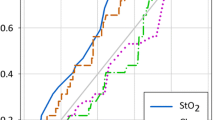Abstract
Introduction
We investigated the relation between tissue oxygen saturation measured by near-infrared spectroscopy (NIRS) and anastomotic complications associated with colorectal surgery.
Methods
A series of 20 patients with colorectal cancer underwent radical surgery with enteric anastomosis. Measurements of tissue oxygen saturation (StO2) were performed at both the proximal and distal portions of the anastomotic site; in cases of anterior resection, we measured StO2 only in the proximal portion.
Results
Two anastomotic complications (one leakage, one stenosis) occurred in the 20 cases. The StO2 in patients with anastomotic complications was 58.0%, and that in patients without complications was 71.0%. Altogether, 18 patients had StO2 values > 66%, and none of them had anastomotic complications. In contrast, 2 patients had StO2 values < 60%, and both had anastomotic complications.
Conclusions
The StO2 of the anastomotic site can be safely and reliably measured by NIRS during colorectal surgery. Low StO2 on both sides of the anastomosis may indicate an increased risk of anastomotic complications. Further study is needed to determine the cutoff value for StO2 required to prevent serious complications.

Similar content being viewed by others
References
Hirano Y, Omura K, Yoshiba H, et al. Near-infrared spectroscopy for assessment of tissue oxygen saturation of transplanted jejunal autografts in cervical esophageal reconstruction. Surg Today 2005;35:67–72
Betzler M. Surgical technical guidelines in intestinal ischemia. Chirurg 1998;69:1–7
Freeman DE, Gentile DG, Richardson DW, et al. Comparison of clinical judgment, Doppler ultrasound, and fluorescein fluorescence as methods for predicting intestinal viability in the pony. Am J Vet Res 1988;49:895–900
Whitehill TA, Pearce WH, Rosales C, et al. Detection thresholds of nonocclusive intestinal hypoperfusion by Doppler ultrasound, photoplethysmography, and fluorescein. J Vasc Surg 1988;8:28–32
Shikata J, Shida T. Effects of tension on local blood flow in experimental intestinal anastomoses. J Surg Res 1986;40:105–111
Hulten L, Lindhagen J, Lundgren O, et al. Regional intestinal blood flow in ulcerative colitis and Crohn’s disease. Gastroenterology 1977;72:388–396
Hulten L, Jodal M, Lindhagen J, et al. Blood flow in the small intestine of cat and man as analyzed by an inert gas washout technique. Gastroenterology 1976;70:45–51
Selkurt EE, Warhen RL. Washout of intra-arterially injected xenon-133 from the intestine of the dog as a method for estimating blood flow. Gastroenterology 1967;52:387–390
Perbeck L, Lindquist K, Liljeqvist L. The mucosal blood flow in pelvic pouches in man: a methodologic study of fluorescein flowmetry. Dis Colon Rectum 1985;28:931–936
Perbeck L, Lund F, Svensson L, et al. Fluorescein flowmetry: a method for measuring relative capillary blood flow in the intestine. Clin Physiol 1985;5:281–292
Knudson MM, Bermudez KM, Doyle CA, et al. Use of tissue oxygen tension measurements during resuscitation from hemorrhagic shock. J Trauma 1977;42:608–614
Schwarz B, Hofstotter H, Salak N, et al. Effects of norepinephrine and phenylephrine on intestinal oxygen supply and mucosal tissue oxygen tension. Intensive Care Med 2001;27:593–601
Ikeda Y, Niimi M, Kan S, et al. Clinical significance of tissue blood flow during esophagectomy by laser Doppler flowmetry. J Thorac Cardiovasc Surg 2001;122:1101–1106
Boyle NH, Pearce A, Hunter D, et al. Scanning laser Doppler flowmetry and intraluminal recirculating gas tonometry in the assessment of gastric and jejunal perfusion during oesophageal resection. Br J Surg 1998;85:1407–1411
Kawasuji M, Yasuda T, Tomita S, et al. Near-infrared monitoring of myocardial oxygenation during intermittent warm blood cardioplegia. Eur J Cardiothorac Surg 1997;12:236–241
Horvath KA, Schomacker KT, Lee CC, et al. Intraoperative myocardial ischemia detection with laser-induced fluorescence. J Thorac Cardiovasc Surg 1994;107:220–225
Walter B, Bauer R, Krug A, et al. Simultaneous measurement of local cortical blood flow and tissue oxygen saturation by near infra-red laser Doppler flowmetry and remission spectroscopy in the pig brain. Acta Neurochir Suppl 2002;81:197–199
Valipour A, McGown AD, Makker H, et al. Some factors affecting cerebral tissue saturation during obstructive sleep apnoea. Eur Respir J 2002;20:444–450
Kusaka T, Isobe K, Nagano K, et al. Quantification of cerebral oxygenation by full-spectrum near-infrared spectroscopy using a two-point method. Comp Biochem Physiol A Mol Integr Physiol 2002;132:121–132
El-Desoky AE, Seifalian A, Cope M, et al. Changes in tissue oxygenation of the porcine liver measured by near-infrared spectroscopy. Liver Transpl Surg 1999;5:219–226
Hampson NB, Piantadosi CA. Near infrared monitoring of human skeletal muscle oxygenation during forearm ischemia. J Appl Physiol 1988;64:2449–2457
Yoxall CW, Weindling AM. Measurement of venous oxyhaemoglobin saturation in the adult human forearm by near infrared spectroscopy with venous occlusion. Med Biol Eng Comput 1997;35:331–336
Author information
Authors and Affiliations
Corresponding author
Rights and permissions
About this article
Cite this article
Hirano, Y., Omura, K., Tatsuzawa, Y. et al. Tissue Oxygen Saturation during Colorectal Surgery Measured by Near-infrared Spectroscopy: Pilot Study to Predict Anastomotic Complications. World J. Surg. 30, 457–461 (2006). https://doi.org/10.1007/s00268-005-0271-y
Published:
Issue Date:
DOI: https://doi.org/10.1007/s00268-005-0271-y




